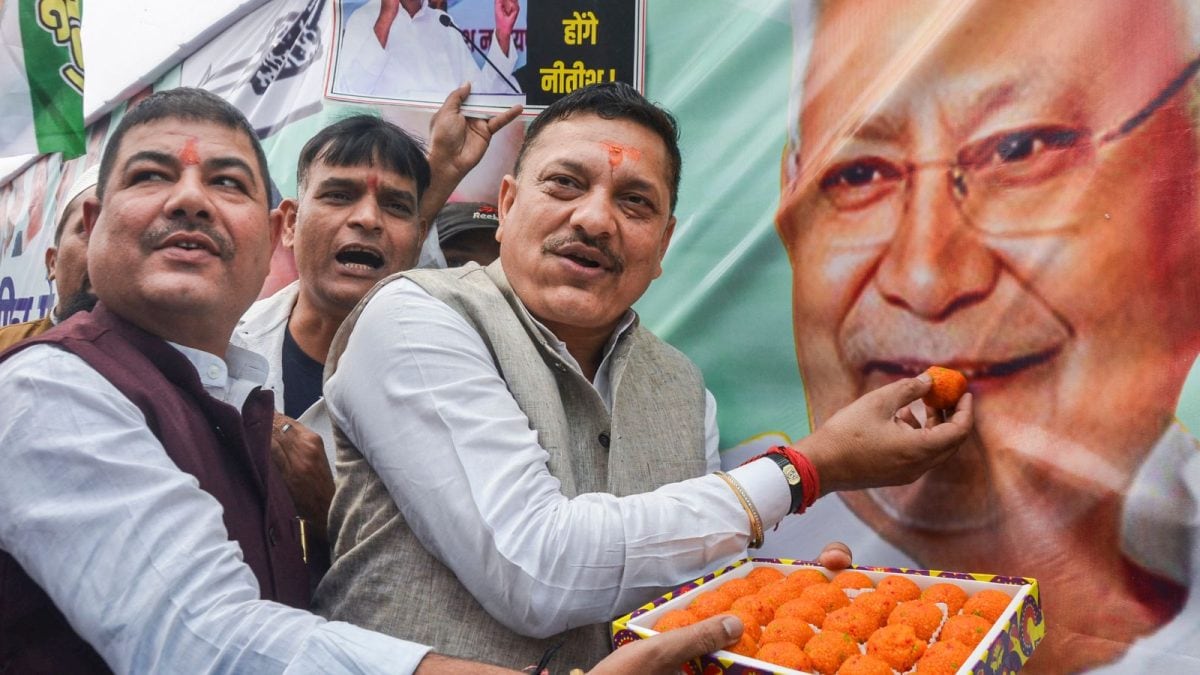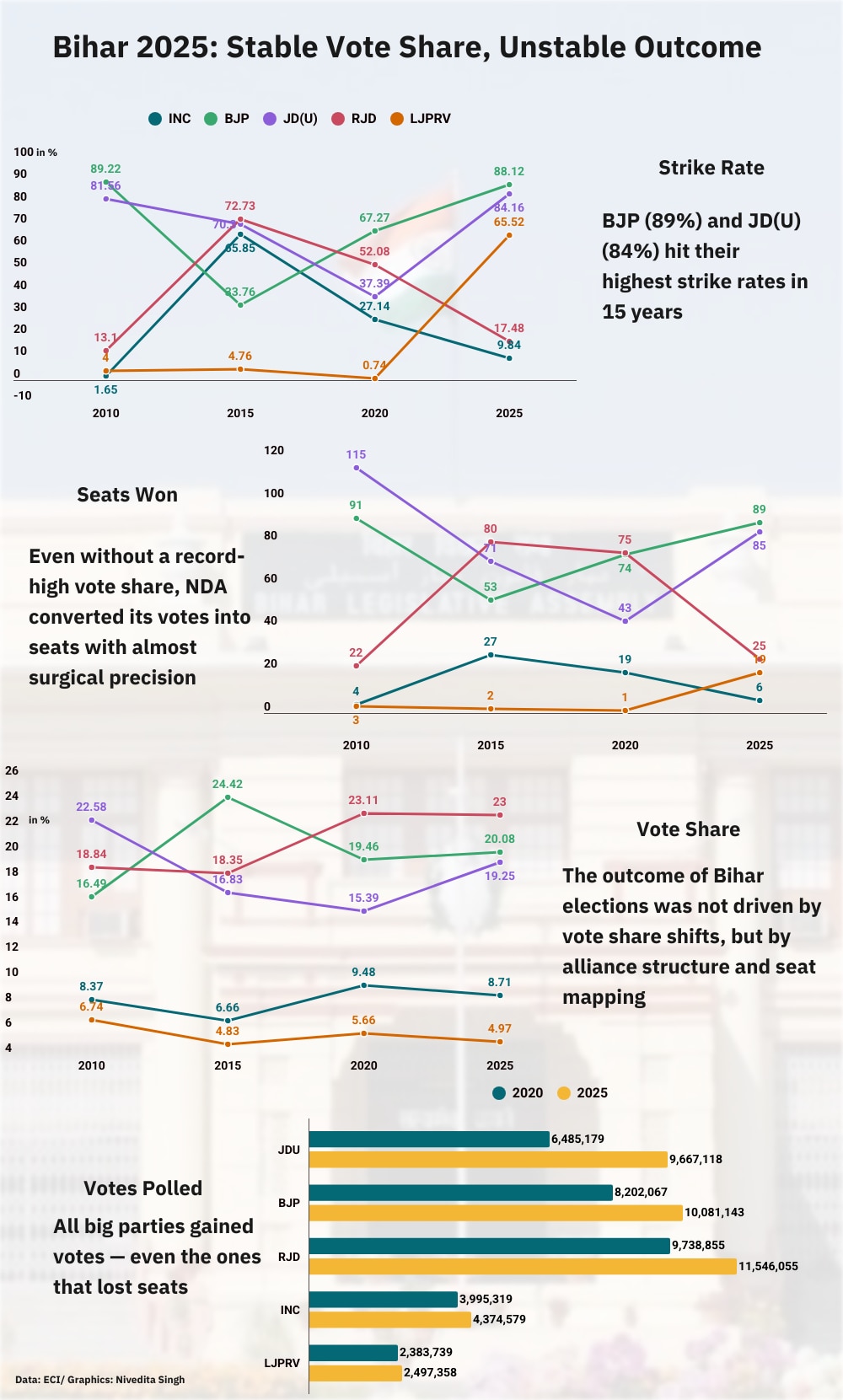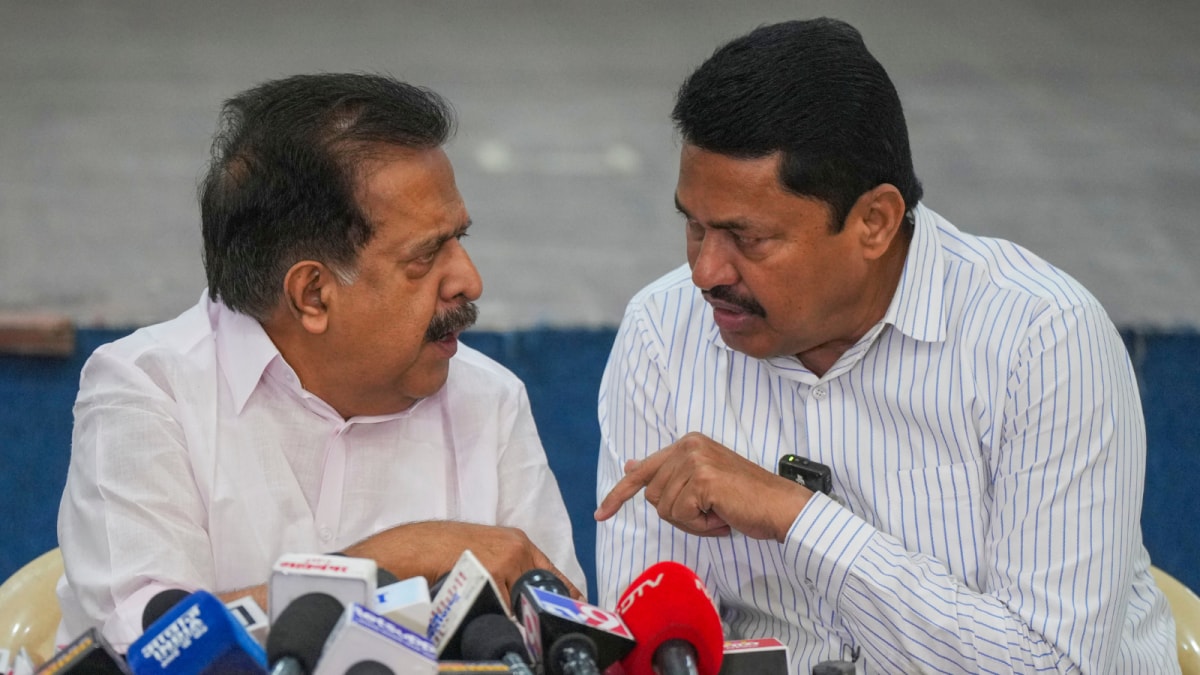Last Updated:
The voting pattern—with almost 80 lakh more votes polled in 2025—shows that the electorate stayed exactly where it was, yet the victory map of the state has changed

The JDU was the biggest winner in the game—an addition of 32 lakh votes in its bag, pushing the party’s vote share from 15.39 per cent to 19.25 per cent. (PTI)
The Bihar results declared on Friday have not changed the fate of ruling parties and their vote share to a large extent, yet there was a political earthquake that shifted the ground reality as the state produced one of the most dramatic seat swings in recent history.
When compared to 2020, JD(U) doubled its seats, BJP almost touched its historic peak with a marginal increase in vote share, while RJD collapsed by 50 seats without losing even a single percentage point of vote share.
In 2020, the state recorded 4.19 crore votes, about 57 per cent voter turnout. This time, the turnout improved to 66.91 per cent—around 4.98 crore votes. The total registered voters in the state has changed from 7.36 crore in 2020 to 7.45 crore this year.
The voting pattern—with almost 80 lakh more votes polled in 2025—shows that the electorate stayed exactly where it was, yet the victory map of the state has changed.
The top five parties in the state—Bharatiya Janata Party (BJP); Janata Dal (United) (JDU); Rashtriya Janata Dal (RJD); Lok Janshakti Party (Ram Vilas) (LJPRV) and Indian National Congress (INC)—have won 224 seats collectively in 2025, up from 212 seats out of 243 in 2020. The vote share has gone up to 76 per cent from 73 per cent in 2020. Of the 80 lakh additional votes polled, 75 lakh went to these parties with all five parties gaining votes.
The LJPRV was formed in 2021 by Chirag Paswan after the death of his father and Lok Janshakti Party founder Ram Vilas Paswan. The data for LJP was used for the previous elections.
So, what exactly has changed in 2025?
With a similar vote share, the performance of the individual parties in terms of seats bagged has changed the political picture of the state, with RJD emerging as the biggest loser. The party, formed by Lalu Prasad Yadav, was to give the chief minister in case their alliance won. Lalu’s son Tejashwi Yadav was the leader of the opposition in Bihar.
The vote share of the RJD, the main opposition in the state, remained around 23 per cent in both the years. However, the seats bagged by the party with the highest vote share in the state dropped to 25 in 2025 from 75 in 2020. In terms of votes, the RJD secured 1.15 crore votes in 2025, up from 97.38 lakh in 2020.
The Congress has lost less than one per cent of the vote share, but the drop translated to a loss of 13 seats.
The vote share of BJP improved from 19.46 per cent to 20.08 per cent. But this translated to 15 additional seats, making it the largest party in terms of seats. The BJP secured over one crore votes in 2025, up from 82 lakh in 2020.
The JDU was the biggest winner in the game—an addition of 32 lakh votes in its bag, pushing the party’s vote share from 15.39 per cent to 19.25 per cent. This addition has doubled the seats bagged by the party—from 43 in 2020 to 85 now.
JDU president Nitish Kumar will continue to be the chief minister of the state. He is already the longest-serving chief minister whilst also holding the post for his ninth term. He has been serving the post since 2015. Previously, he held the office from 2005 to 2014 and for a short period in 2000.
This uneven conversion happened because the NDA’s votes were more geographically concentrated, while the Opposition’s votes were widely dispersed and failed to turn into wins.
Both BJP (89 per cent) and JD(U) (84 per cent) recorded their highest strike rates in 15 years, converting almost every seat they seriously contested.
The runner-up map explains the seat shock.
Further analysis of the data from the ECI shows that RJD has not disappeared from Bihar’s map in 20252025, it just slid one row down, from the winner’s column to the runner-up column.
RJD came second on 113 seats—nearly half the assembly. In 29 seats, the party’s lost margin was less than 10,000 votes and in 13 of these it was less than 5,000 votes.
Congress came second on 48 seats and the lost margin ranged between 5,600 votes and over 50,000 votes.
The Communist Party of India (Marxist-Leninist) (Liberation) (CPI(ML)) that won just two seats in Bihar, came second on 16 seats while the BJP was second on 11 seats. The JDU finished second on 17 seats.
The BJP-JDU led NDA has bagged 202 seats in Bihar in total. The Bihar 2025 verdict shows how stable vote shares can produce unstable outcomes when alliances, geographical distribution and seat-level dynamics shift. With almost no movement in political preferences, the state still wrote a dramatically different story.

Nivedita Singh is a data journalist and covers the Election Commission, Indian Railways and Ministry of Road Transport and Highways. She has nearly seven years of experience in the news media. She tweets @nived…Read More
Nivedita Singh is a data journalist and covers the Election Commission, Indian Railways and Ministry of Road Transport and Highways. She has nearly seven years of experience in the news media. She tweets @nived… Read More
November 15, 2025, 10:56 IST
Read More









